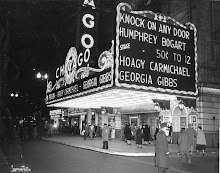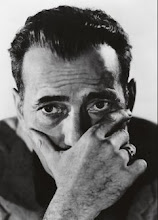
Fifteen minutes in and my eyeballs were screaming "pull back! for god's sake please pull back!!"
The majority of PUBLIC ENEMIES is shot in hi-def close up or extreme close up and the effect is relentless. My eyes got claustrophobic. If they had lungs they'd have been struggling to breathe.
Other than exposing Johnny Depp's every pore and blemish I'm still trying to figure out exactly what director Michael Mann's intention is in keeping the camera so very close to the action. On many occasions it is so close it's impossible to see the action properly. Possibly he wants to convey a sense of Depp's character, 30s American gangster John Dillinger, being hemmed in by fate and unable to escape his destiny. The flaw in that theory is that Dillinger is offered an out and chooses not to take it. Rather like Bogart's Roy "Mad Dog" Earle in "High Sierra" (1941) Dillinger is rushing towards death and doing so willingly.
A string of bank robberies across the Midwest in the early 1930s had made him Public Enemy Number One and the focus of FBI director J Edgar Hoover's wrath. He assigns his best agent, Melvin Purvis (played by Christian Bale) to the case with orders to do whatever's necessary to bring an end to Dillinger's activities. PUBLIC ENEMIES is the story of their long drawn-out final showdown, with Dillinger miraculously succeeding in repeatedly outwitting Purvis despite the FBI's superior manpower.
In the process Dillinger becomes something of a folk hero which only serves to infuriate Hoover (played by Billy Crudup) further. Dillinger was one of the first famous criminals to recognise the importance of good PR. He wasn't averse to using hostages as human shields while he shot his way out of the banks he'd just stuck up, but he drew the line at kidnapping for ransom because he knew that wouldn't go down well with the public.
Depp's portrayal of Dillinger is notable for its understatement. Think back over the history of big screen gangsters and the ones that stand out do so because they're a) larger than life, and b) usually psychotic. Depp's Dillinger is actually a pretty regular guy who happens to have a flair for armed robbery. He dreams of stealing enough money to buy a better life somewhere far away with his girl Billie (played by Marion Cotillard with a passable American-ish accent). But the strong suspicion is that dreams are all these are, that Dillinger's sense of himself is shaped entirely by the thrill of crime and outwitting the authorities.
Playing opposite Depp is a thankless task but Bale acquits himself well. There's considerably less depth to his character and, despite representing the forces of law and order, considerably less sympathy for him.
Admirers of Mann's earlier crime thriller "Heat" will recognise similarities with his latest project. Both involve a cat and mouse game between two determined characters on either side of the law, both feature only one scene in which these two actually meet, and both films are visually stunning. Mann's manipulation of colour to recreate the texture of the 1930s is worthy of an Oscar nomination. He makes it possible for us to believe the decade existed in colour rather than the black and white of the movies produced back then.
At a leisurely two hours and twenty three minutes PUBLIC ENEMIES requires a little patience. I liked this film but I didn't love it.


No comments:
Post a Comment